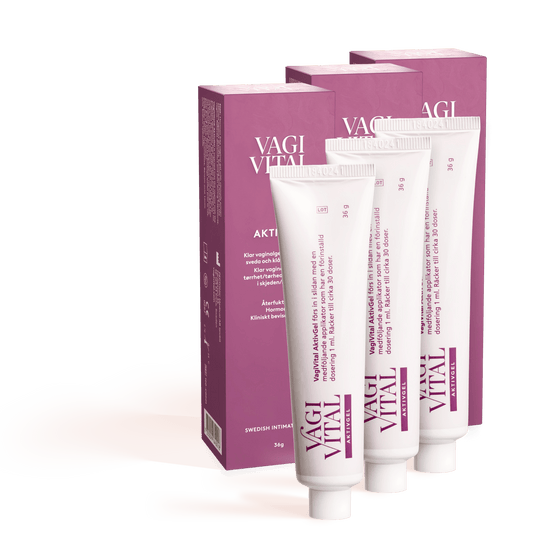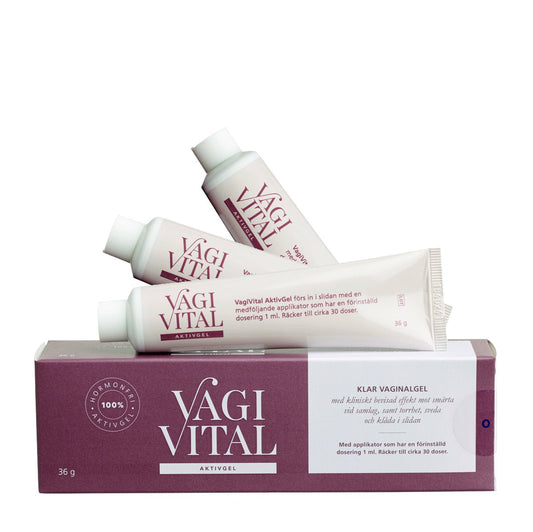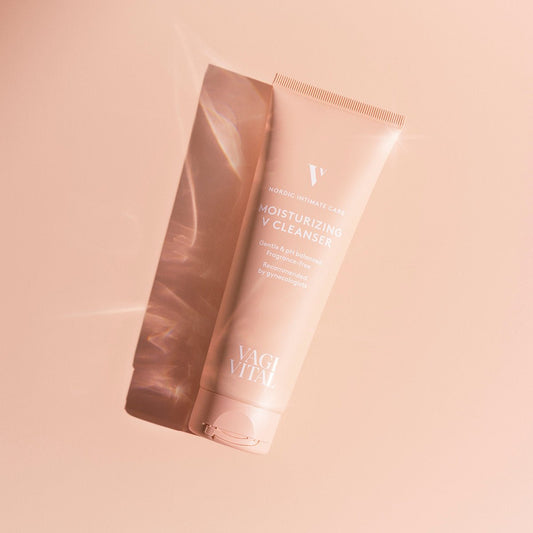Keep the vaginal flora healthy - prevent unpleasant-smelling discharge, yeast infections & urinary tract infections
When I invested in three new bikinis ahead of the long-awaited summer, I had two strong motives: partly because I am simply vain but above all the ancient wisdom that cold and wet bikini bottoms are no good as they can potentially affect the vaginal microflora and increase the risk of discomfort, such as yeast infections or bacterial imbalance. I looked forward to a warm summer with many swims and several dry bikini changes but have so far only used one bikini at a few swims due to a cold and rainy summer, but on the other hand, my vaginal microflora is doing excellent!
Did you know, by the way, that there are more microorganisms crowded in a woman's vaginal flora than there are people on this planet? Yes, you read that right! There can be hundreds of millions to billions of tiny microbes hanging around having a lively microbial party in the vagina. These small, invisible superheroes make up a whole army with a mission no less than to dedicatedly serve your well-being ❤.
WHAT IS VAGINAL FLORA?
Vaginal flora is the collection of microorganisms, including bacteria, that naturally occur in the vagina of women and are important for the vagina to thrive and be healthy.
The vaginal flora mainly consists of different types of bacteria, most of which are lactic acid bacteria (lactobacilli). These bacteria help keep the vaginal pH acidic, creating an inhospitable environment for harmful microorganisms such as unfriendly viruses, bacteria, and fungi.
BENEFITS OF A BALANCED VAGINAL FLORA
Your little microorganisms are like small and very caring tenants in a very cozy home ❤ They want to do everything to create as healthy and protective an environment in the vagina as possible. But for them to do their job, they also need the right conditions.
A balanced and acidic (read happy😊) vaginal flora:
🌸Makes the vagina acidic (read happy 😊) and governs pH
Lactobacilli help maintain the vaginal pH balance, which is important to prevent the overgrowth of harmful microorganisms. Lactobacilli produce lactic acid by breaking down sugars in the vagina. Lactic acid lowers the pH value in the vagina and makes the environment acidic. This acidic pH (usually below 4.5) is inhospitable to many harmful microorganisms, including certain bacteria and fungi that can cause infections.
🌸Reduces the risk of infections
A healthy vaginal flora is linked to a reduced risk of certain sexually transmitted infections. The acidic environment created by lactobacilli acts as a natural barrier against unwanted organisms by preventing their growth and survival. This reduces the risk of infections such as bacterial vaginosis and yeast infections.
🌸 Protects the vaginal mucous membranes
The vaginal flora helps protect the vaginal mucous membranes and keep them healthy. The lactobacilli contribute to strengthening the mucous membranes in the vagina and keeping them healthy. This also reduces the risk of irritation and inflammation.
SYMPTOMS OF IMBALANCE IN THE VAGINAL FLORA
The vaginal flora can vary from person to person and also change over time due to hormonal changes, sexual activity, pregnancy, and the use of antibiotics or hormonal contraceptives. Imbalances in the vaginal flora can sometimes lead to unwanted symptoms such as itching, irritation, foul-smelling discharge, and infections like bacterial vaginosis or yeast infections. An imbalance in the vaginal flora can cause various symptoms and discomfort. Here are some common symptoms that may occur with such an imbalance:
Foul-smelling discharge
An unpleasant or fishy smell from vaginal discharge can be a sign of imbalance. It may indicate that harmful bacteria have increased and dominate over the good lactic acid bacteria.
Read the blog on bacterial vaginosis and foul-smelling discharge here
Itching and irritation
Itching and irritation around the vagina and surrounding areas are common symptoms of an imbalance. It can be a result of irritation from overgrowth of certain types of bacteria or yeast.
Read the blog on how to get rid of yeast infection in the vagina here
Increased amount of discharge
An increased amount of vaginal discharge, especially if it has a different color, consistency, or smell than usual, can be a sign of imbalance.
Burning or stinging sensation
A burning or stinging sensation during urination or generally around the vagina can occur with an imbalance in the vaginal flora.
Pain during intercourse
Imbalance in the vaginal flora can make the mucous membranes more sensitive, which in turn can cause pain during intercourse.
Increased sensitivity to infections
An impaired balance in the vaginal flora can make the vagina more susceptible to infections such as yeast infections or bacterial vaginosis.
Changes in pH level
An imbalance can affect the vaginal pH level, which in turn can lead to a less acidic environment than normal. This can create a favorable environment for harmful microorganisms to grow.
Vaginal Dryness
Dry mucous membranes can lead to discomfort such as itching, burning sensation, pain during intercourse, and increased sensitivity to irritation. The secret behind VagiVital AktivGel for dry mucous membranes is that it has a high viscosity and a low surface tension, which means it adheres to the vaginal mucosa where it releases moisture, restores pH, and stimulates the growth of cells in the mucosal surface layer. For a vaginal gel to work, it must also have an ideal osmolality – that is, the ultimate moisturizing ability adapted to the environment in which it acts. The low osmolality of AktivGel is adapted to the vaginal environment and makes the crystal-clear gel simply stay where it is placed and then release water to the mucosa over time.
You can find VagiVital AktivGel here
Urinary Tract Infections (UTI)
Decreased lactobacilli and a higher pH level can increase the risk of urinary tract infections.
Read blog about urinary tract infection here
VAGINAL FLORA AND HORMONAL CHANGES
Hormonal changes in the body affect estrogen levels, which in turn affect the amount and type of bacteria in the vaginal flora as well as the acidity of the vagina.
Puberty
During puberty, estrogen levels increase. This leads to lactobacilli, the good lactic acid bacteria, beginning to thrive in the vagina. This increase in lactobacilli helps create an acidic environment in the vagina through the production of lactic acid. The acidic environment helps prevent the growth of harmful microorganisms and thereby promotes vaginal health.
Menstrual Cycle
Estrogen levels vary during the menstrual cycle. Before ovulation, estrogen production increases and contributes to an increased amount of lactobacilli and an acidic environment in the vagina. During menstruation, the pH level can temporarily become slightly higher, which can affect the balance of the vaginal flora and make it easier for certain harmful microorganisms to grow.
Pregnancy
During pregnancy, estrogen levels increase significantly. This can lead to an increased amount of lactobacilli and a stronger acidic environment in the vagina. This environment helps protect both the mother and the fetus from potential infections.
The Menopause
During menopause, estrogen levels drop dramatically. This can affect the vaginal tissue and reduce the amount of lactobacilli. The acidic environment becomes less strong, which can open the way for the growth of other types of bacteria and microorganisms. This can make the vagina more susceptible to infections and discomfort. When estrogen production decreases during menopause, several changes can occur in the vaginal microflora and vaginal mucosa:
🌸 Decreased Amount of Lactobacilli
Since estrogen is important for stimulating the growth of lactobacilli, their number can decrease when estrogen production decreases. This can lead to a less acidic environment in the vagina and an increased risk of imbalance in the microflora.
🌸 Thinner Vaginal Mucosa
Decreased estrogen levels can affect the thickness and elasticity of the vaginal mucosa. A thinner mucosa can be more susceptible to damage and irritation.
🌸 Increased Dryness
Decreased estrogen production can lead to vaginal dryness, which can make the vagina less hospitable for the good bacteria and increase the risk of infections and discomfort.
Read blog about understanding and managing dry mucous membranes here
🌸 Higher pH level
The reduced amount of lactobacilli can result in a higher pH level in the vagina, creating a more favorable environment for the growth of harmful microorganisms.
TIPS TO PROMOTE A HEALTHY VAGINAL FLORA
Promoting a healthy vaginal flora is crucial for well-being and intimate health. Here are some tips that can help maintain a balanced and healthy vaginal flora:
Choose healthy cleansing
Avoid excessive intimate washing and also choose the right product for intimate cleansing. A soap risks drying out the vagina and can disturb the natural balance in the vaginal flora while an oil can only remove fat-soluble impurities. Our patented intimate wash VagiVital V Cleanser is designed to gently cleanse both oil-based and water-based impurities without disturbing the vaginal flora or pH balance in the vagina and is specially developed to cleanse, moisturize, and restore the pH balance in the genital area. It is based on VagiVital's clinically proven and moisturizing AktivGel formula as well as mild rapeseed oil. Of course, completely free from soap, perfume, and parabens and recommended by gynecologists.
You can find VagiVital V Cleanser here
Avoid perfumed products
Perfumed products such as tampons, panty liners, or soaps can irritate and disturb the balance in the vagina. Use unscented alternatives and try, for example, cloth pads as an option during menstruation.
Choose the right underwear
Cotton panties are a good choice because they allow air circulation and reduce moisture, which in turn reduces the risk of imbalance. Choosing a material that allows air circulation reduces moisture and helps prevent the overgrowth of harmful bacteria and fungi.
Read blog about yeast infection in the genital area here
Change wet underwear
Damp underwear can promote the growth of harmful microorganisms. Change wet bikini underwear and sweaty panties as soon as possible.
Urinating after intercourse & use condoms
Sexually transmitted infections obviously affect the vaginal flora, where condoms are always a good protection. Semen can actually also affect the vaginal flora to some extent as semen can change the pH value in the vagina and thereby affect the microbial balance. This is because semen is alkaline (has a higher pH) compared to the acidic environment that lactobacilli create in a healthy vaginal flora. The temporary pH change after intercourse can therefore allow certain harmful microorganisms a short-term opportunity to grow excessively, which can lead to a temporary imbalance in the vaginal flora. Urinating after intercourse can therefore be a recommendation that reduces the risk of irritation and imbalance in the vaginal flora.
Avoid excessive use of antibiotics
Antibiotics can affect the normal bacterial balance in the body, including the vaginal flora. Use antibiotics only as directed by a doctor.
Be careful with intimate shaving
Shaving can cause irritation of the sensitive skin in the genital area, which can lead to itching, redness, and discomfort. Intimate shaving can also disrupt the skin's natural protective barrier and make the skin more susceptible to infections and irritation. Pubic hair also has an important function as it creates an air gap between the underwear and the skin, which helps maintain a favorable environment with a balanced pH value and good lactobacilli that help keep unwanted guests (bacteria) away.
Read blog about intimate shaving here
RESEARCH & VAGINAL FLORA
New advances in technologies such as DNA sequencing (reading and understanding the building blocks of the DNA molecule) and microbiome research (research on microorganisms and their impact on health) have opened up opportunities to gain a deeper understanding of the microbial world in the vagina. Through these technologies, researchers have been able to study vaginal microflora at a more detailed level. In their studies, they have focused on identifying the exact microorganisms present in a healthy vaginal environment. They have also tried to understand the different functions these microorganisms have as well as how they interact with the body's own tissues.
The results from this research have the potential to revolutionize our understanding of vaginal health and how we manage it. By mapping the specific bacteria and other microorganisms present in a healthy vaginal flora, and by understanding how they interact with the surrounding host organism, we can gain better insight into the complex processes that affect vaginal health. This knowledge may in the future lead to new ways to prevent and treat problems related to vaginal microflora, thereby improving women's well-being and health in a completely new way.
DO YOU WANT TO KNOW MORE ABOUT VAGINAL FLORA?
Read the book "Vulva: facts, myths, and life-changing insights" by Ina Schuppe Koistinen, associate professor in medical science, who is a renowned Swedish researcher whose work has focused on various aspects of vaginal flora and its impact on women's health. Her research has shed light on the connection between the composition of vaginal flora and infections such as bacterial vaginosis and urinary tract infections. By examining how different factors, including hormonal changes and sexual activity, affect the balance of vaginal flora, Ina Schuppe Koistinen has contributed to a deeper understanding of the complexity of the microflora and its impact on health and well-being.
Take care of yourself and your invisible superheroes – your vaginal flora. They work tirelessly and quietly behind the scenes to keep your vagina strong and healthy ❤
By Fanny Falkman Grinndal
Recommended products for you
- Choosing a selection results in a full page refresh.
- Opens in a new window.













